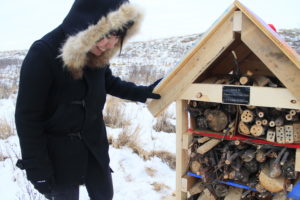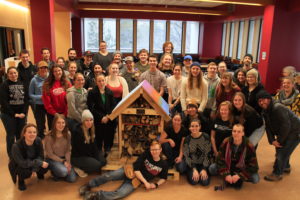Meewasin and University of Saskatchewan Bee Hotel Project
Meewasin exists to ensure a healthy and vibrant river valley, with a balance between human use and conservation for current and future generations. With our funding partners, including the University of Saskatchewan, we work closely to strengthen the community within Saskatoon in regards to education and conservation, collaborating on a variety of projects, solving real world concerns.
The bee hotel project
During fall 2019, students from the U of S College of Education took part in a Pedagogies of Place class participated in a class project which taught them about place-based learning and stewardship. The class worked with Meewasin to create and set up a ‘bee hotel’ at the Northeast Swale, to improve the habitat for our local pollinators that call this important site home. We spoke to a few of the students about their experience.
Why do bees need a hotel and what are they made of?
Solitary bees, who are fantastic pollinators, live alone instead of in hives, so they must find a small

hole to lay their eggs, so a bee hotel gives them a place to do so. The class built their bee house out of old pallets, plywood, gathered sticks and logs and drilled holes in them, big enough so that the bees can fit inside the holes and lay their eggs. These types of bees also depend on wild flowers native to our local ecosystem to provide essential resources of pollen and nectar for them to survive, making the Northeast Swale a wonderful area for them.
Why is this an important project?
The purpose of the project is to help “create a healthy bee population, as it’s something that is essential for our current climate situation.” In addition to this, they chose this project, because it “was something that we could all come together on and combine disciplines, because we’re all from different teaching practices.” According to the students, Meewasin was a big influence in deciding to pursue this project, as it taught them about how new developments around the Northeast Swale have a concerning impact on the local bee populations. This influence began with introducing some of the students to the Swale for the first time, and describing its importance to our ecosystem and the surrounding residents of Saskatoon.
Meewasin’s role as stewards of the river valley
The students learned a lot about what Meewasin’s role is in the community and as stewards of the river valley, about which they noted, “It’s inspiring to see what Meewasin is working to protect in the Saskatoon region. We were inspired seeing that you can take action and make a difference in that way. Because Meewasin showed us that, it inspired us to start our own project”. They noted that this connection with Meewasin is very rewarding, and allowed them to access many other resources, saying it’s a partnership they can take forward into their own classrooms.
Why is this a good project?
The class was more than enthusiastic about the project, responding with “Absolutely”, “Definitely”, and “For sure” when asked if they would do a similar type of project with their future classes. The undergrads spoke about the value they see in a project like this; including:
- Allowing students to see the impact they are making
- Teaching younger generations about ecological and social justice action
- Promoting the creation of connections and collaborating in new ways that you wouldn’t experience just sitting in a regular classroom, and
- Driving the inquiry process in a way that is more in the hands of the students.
Another significant benefit was promoting a sense of ownership for students to go out and act in their community, and to discover what difference they can make.
Advice for future educators

For other soon-to-be or established teachers, the group gave some advice, remarking “It might seem like a lot of planning, but it’s totally worth it. Not only do you get a lot of kids coming together, but you get interdisciplinary focuses, you are actually doing something authentic so it’s worth collaborating and taking the time to plan it”. Another student said it’s a rewarding experience because “You can really see it, you have a physical thing you can appreciate after you’ve worked together, which is very accomplishing.” It also “teaches your students how important the environment really is, and what is going on in the world, and it connects them to it as they’re the ones making the impact.”
In Conclusion
Solitary bees are amazing creatures that help pollinate much of the food that we eat. We want to help them out by building bee hotels, since they lay their eggs in small holes. Educators and nature lovers of all kinds should involve collaborative projects into their lives that also allow them to learn about the environment and natural spaces, such as a bee hotel. You can build your own be hotel to help out this crucial native species. Learn all the how tos at Nature Conservancy of Canada’s ‘Bee our Guest’ blog.
Meewasin works to engage students and lifelong learners about the benefits and the opportunities to make natural areas an outdoor classroom learning experience. If you are interested in reading more about Meewasin’s partnerships and work with students, or how to get involved, please visit www.meewasin.com and sign up for our eNewsletter!




